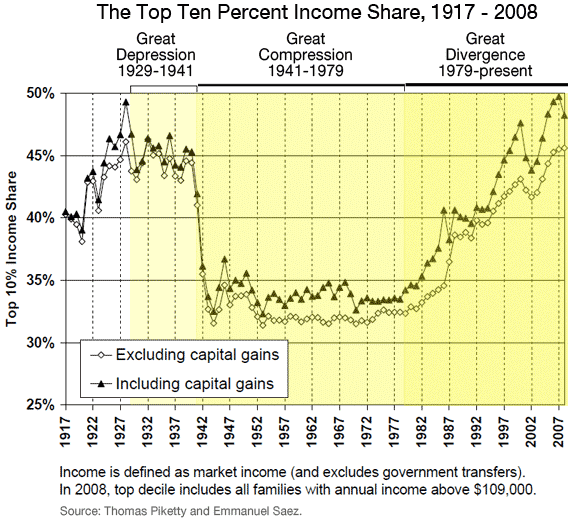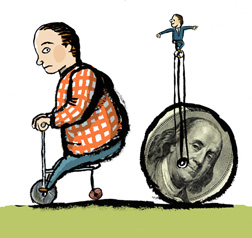The United States of Inequality
In 1915, a statistician at the University of Wisconsin named Willford I. King published The Wealth and Income of the People of the United States, the most comprehensive study of its kind to date. The United States was displacing Great Britain as the world's wealthiest nation, but detailed information about its economy was not yet readily available; the federal government wouldn't start collecting such data in any systematic way until the 1930s. One of King's purposes was to reassure the public that all Americans were sharing in the country's newfound wealth.
King was somewhat troubled to find that the richest 1 percent possessed about 15 percent of the nation's income. (A more authoritative subsequent calculation puts the figure slightly higher, at about 18 percent.)
This was the era in which the accumulated wealth of America's richest families—the Rockefellers, the Vanderbilts, the Carnegies—helped prompt creation of the modern income tax, lest disparities in wealth turn the United States into a European-style aristocracy. The socialist movement was at its historic peak, a wave of anarchist bombings was terrorizing the nation's industrialists, and President Woodrow Wilson's attorney general, Alexander Palmer, would soon stage brutal raids on radicals of every stripe. In American history, there has never been a time when class warfare seemed more imminent.
That was when the richest 1 percent accounted for 18 percent of the nation's income. Today, the richest 1 percent account for 24 percent of the nation's income. What caused this to happen? Over the next two weeks, I'll try to answer that question by looking at all potential explanations—race, gender, the computer revolution, immigration, trade, government policies, the decline of labor, compensation policies on Wall Street and in executive suites, and education. Then I'll explain why people who say we don't need to worry about income inequality (there aren't many of them) are wrong.
Income inequality in the United States has not worsened steadily since 1915. It dropped a bit in the late teens, then started climbing again in the 1920s, reaching its peak just before the 1929 crash. The trend then reversed itself. Incomes started to become more equal in the 1930s and then became dramatically more equal in the 1940s. Income distribution remained roughly stable through the postwar economic boom of the 1950s and 1960s. Economic historians Claudia Goldin and Robert Margo have termed this midcentury era the "Great Compression." The deep nostalgia for that period felt by the World War II generation—the era of Life magazine and the bowling league—reflects something more than mere sentimentality. Assuming you were white, not of draft age, and Christian, there probably was no better time to belong to America's middle class.
The Great Compression ended in the 1970s. Wages stagnated, inflation raged, and by the decade's end, income inequality had started to rise. Income inequality grew through the 1980s, slackened briefly at the end of the 1990s, and then resumed with a vengeance in the aughts. In his 2007 book The Conscience of a Liberal, the Nobel laureate, Princeton economist and New York Times columnist Paul Krugman labeled the post-1979 epoch the "Great Divergence."
It's generally understood that we live in a time of growing income inequality, but "the ordinary person is not really aware of how big it is," Krugman told me. During the late 1980s and the late 1990s, the United States experienced two unprecedentedly long periods of sustained economic growth—the "seven fat years" and the " long boom." Yet from 1980 to 2005, more than 80 percentof total increase in Americans' income went to the top 1 percent. Economic growth was more sluggish in the aughts, but the decade saw productivity increase by about 20 percent. Yet virtually none of the increase translated into wage growth at middle and lower incomes, an outcome that left many economists scratching their heads.
Here is a snapshot of income distribution during the past 100 years:

Why don't Americans pay more attention to growing income disparity? One reason may be our enduring belief in social mobility. Economic inequality is less troubling if you live in a country where any child, no matter how humble his or her origins, can grow up to be president. In a survey of 27 nations conducted from 1998 to 2001, the country where the highest proportion agreed with the statement "people are rewarded for intelligence and skill" was, of course, the United States. (69 percent). But when it comes to real as opposed to imagined social mobility, surveys find less in the United States than in much of (what we consider) the class-bound Old World. France, Germany, Sweden, Denmark, Spain—not to mention some newer nations like Canada and Australia—are all places where your chances of rising from the bottom are better than they are in the land of Horatio Alger's Ragged Dick.
How you compare:
$52,059
All my life I've heard Latin America described as a failed society (or collection of failed societies) because of its grotesque maldistribution of wealth. Peasants in rags beg for food outside the high walls of opulent villas, and so on. But according to the Central Intelligence Agency (whose patriotism I hesitate to question), income distribution in the United States is more unequal than in Guyana, Nicaragua, and Venezuela, and roughly on par with Uruguay, Argentina, and Ecuador. Income inequality is actually declining in Latin America even as it continues to increase in the United States. Economically speaking, the richest nation on earth is starting to resemble a banana republic. The main difference is that the United States is big enough to maintain geographic distance between the villa-dweller and the beggar. As Ralston Thorpe tells his St. Paul's classmate, the investment banker Sherman McCoy, in Tom Wolfe's 1987 novel The Bonfire of the Vanities: "You've got to insulate, insulate, insulate."
In 1915, King wrote, "It is easy to find a man in almost any line of employment who is twice as efficient as another employee,"
but it is very rare to find one who is ten times as efficient. It is common, however, to see one man possessing not ten times but a thousand times the wealth of his neighbor. … Is the middle class doomed to extinction and shall we soon find the handful of plutocrats, the modern barons of wealth, lined up squarely in opposition to the propertyless masses with no buffer between to lessen the chances of open battle? With the middle class gone and the laborer condemned to remain a lifelong wage-earner with no hope of attaining wealth or even a competence in his old age, all the conditions are ripe for a crowning class-conflict equaling in intensity and bitterness anything pictured by the most radical follower of Karl Marx. Is this condition soon coming to pass? [emphasis his]
In the end, King concluded it wasn't. Income distribution in the United States, he found, was more equal than in Prussia, France, and the United Kingdom. King was no socialist. Redistributing income to the poor, he wrote, "would merely mean more rapid multiplication of the lowest and least desirable classes," who remained, "from the reproductive standpoint, on the low point of their four-footed ancestors." A Malthusian, he believed in population control. Income inequality in the United States could be addressed by limiting immigration (King deplored "low-standard alien invaders") and by discouraging excessive breeding among the poor ("eugenicists are just beginning to impress upon us the absurd folly of breeding great troops of paupers, defectives and criminals to be a burden upon organized society").
Today, incomes in the U.S. are more unequal than in Germany, France, and the United Kingdom, not less so. Eugenics (thankfully) has fallen out of fashion, and the immigration debate has become (somewhat) more polite. As for income inequality, it's barely entered the national political debate. Indeed, the evidence from the 2000 and 2004 presidential elections suggests that even mild economic populism was a loser for Democrats. (To sample authentic economic populism, click here.)
But income inequality is a topic of huge importance to American society and therefore a subject of large and growing interest to a host of economists, political scientists, and other wonky types. Except for a few Libertarian outliers (whose views we'll examine later), these experts agree that the country's growing income inequality is deeply worrying. Even Alan Greenspan, the former Federal Reserve Board chairman and onetime Ayn Rand acolyte, has registered concern. "This is not the type of thing which a democratic society—a capitalist democratic society—can really accept without addressing," Greenspan said in 2005. Greenspan's Republican-appointed successor, Ben Bernanke, has also fretted about income inequality.
Yet few of these experts have much idea how to reverse the trend. That's because almost no one can agree about what's causing it. This week and next, I will detail and weigh the strengths and weaknesses of various prominent theories as to what has brought about the income inequality boom of the last three decades. At the same time, I'll try to convey the magnitude of its effects on American life. The Great Divergence may represent the most significant change in American society in your lifetime—and it's not a change for the better. Let's see if we can figure out what got us here.
Click here to view a visual guide to inequality. Click here to subscribe to this series. Navigate the series from a single page.
Become a fan of Slate on Facebook. Follow us on Twitter.

